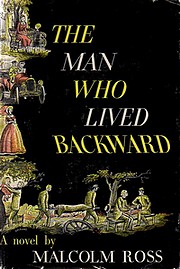 This is the most confusing book I’ve ever read. 400-plus pages and my head still hurts when I try to make sense of it.
This is the most confusing book I’ve ever read. 400-plus pages and my head still hurts when I try to make sense of it.
The Man Who Lived Backward tells the story of Mark Selby, to whom author Malcolm Ross endows a unique form of time-travelling:
“At dawn each day,” he began again, “I awake and enjoy my breakfast. I go about the business and pleasures of the day. I lunch. I dine. I talk with a friend, as I am doing now, and go to my bed secure in the knowledge that the sun will rise to a new day. As you, I have no idea what the day will bring forth. The only difference between us is this: when you awake tomorrow it will be April 18; with me it will be April 16.”
In other words, Mark Selby goes through each day normally, starting in the morning and going through the day to night. But then he goes to bed and wakes up on the morning of the day before.
This is not a work of science fiction. Ross only uses this arrangement as the pretext to take use through a series of historical situations–the siege of Paris in 1871, Pennsylvania steel strikes in the 1890s, the Spanish-American War. He wastes no energy trying to work out the logic of the situation.
I just couldn’t get past it, though. If he has “no idea what the day will bring forth”, then how is he able to have friends? Wouldn’t all his acquaintances be meeting him for the first time in their lives, even if he’d known them for decades ahead? And how is he able to avoid waking up on top of someone else the next day? He spends most of his nights in hotel rooms. How the heck does he pay for them? OK, so he could remember the day before to book a room so that he could wake up there the day after. But how does he change rooms? Wouldn’t that mean that overnight he travels through space AND time–but only when he changes locations? And he sails back and forth across the Atlantic a few times: how does that work? He travels through space AND time and coordinates his trajectory with the path of the ship?
All this is, of course, pointless speculation. As I said, time travel is just a pretext for Ross, and some readers will find enough else in the book to look past this shaky construct. There are several dozen long entries that record, verbatim, conversations Selby has or overseas as he wanders back through time. Three British clubmen discuss liberty in the 1890s, when that concept didn’t even fully apply to all white men, let alone another sex or race. He spends a good deal of time with Walt Whitman and John Burroughs, to the point that he seems to become something of a Whitman groupie. He tells us about the fine and horrible things that were served up to eat during the siege of Paris.
In the hands of a fine raconteur, these diversions would provide excuse enough to go along on any journey, whether backward, forward, or sideways through time. The problem is that Selby himself lacks a distinct enough character to offer much in the way of color, bias, perception, or any other distinguishing flavor to his observations. As a protagonist, he seems more instrument than human creation.
And, to drive one last nail in this book’s coffin, Ross manages to slap not one, but two framing stories to his work without either adding much in the way of narrative tension or interest. First, Ross presents Selby’s diary as an artifact found in the estate of a wealthy New Englander by his grandson. Long suspected of having made his fortune through some sort of under-handedness in the wake of the Civil War, the grandfather is revealed to be the lucky Union soldier to whom Selby passes along some valuable investment tips on the eve of his fatal attempt to thwart Lincoln’s assassination.
Second, there is Selby’s unique love affair with Helen, who somehow passes twenty-some years in a relationship with Selby–one that starts in her young womanhood and ends at his infancy. Theirs, we are repeatedly assured, is a great love story, but for some odd reason, Ross elects to leave almost all of it out of the book. Only chunks of Selby’s diary are included, and none of them directly covering the years of their time together.
 Fiction was not, I should note, Malcolm Ross’ forte. He spent most of his working life as a journalist and labor relations expert, serving as chairman of the Fair Employment Practice Committee through most of World War Two. His first book, Machine Age in the Hills
Fiction was not, I should note, Malcolm Ross’ forte. He spent most of his working life as a journalist and labor relations expert, serving as chairman of the Fair Employment Practice Committee through most of World War Two. His first book, Machine Age in the Hills, was one of the first works to address the hardships and near-bondage of Kentucky coal miners. And his 1939 autobiography, The Death Of A Yale Man
, is still considered one of the more revealing memoirs of the New Deal era.
If any of Mark Selby’s tale strikes a familiar note, it’s probably because you’re thinking of F. Scott Fitzgerald’s short story, “The Curious Case of Benjamin Button,” or its recent film version. Even though it’s one of Fitzgerald’s lesser works, it still towers over The Man Who Lived Backward: it’s got a simpler and sounder fictional premise, a more elegant prose style, and a couple hundred thousand fewer words.
After all, if you have to read a lesser work, make it a short one.
Find a copy
- Find it at Amazon.com: The Man Who Lived Backward
- Find it at Amazon.co.uk: The Man Who Lived Backward
- Find it at AddAll.com: The Man Who Lived Backward

Found this book at a garage sale today, gonna try to read it. Glad it’s been remembered :)